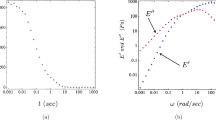Abstract
The problem of describing the behavior of a highly filled polymeric material under compression, which was preceded by preliminary compression and unloading, is considered. The peculiarity of the compression diagrams obtained in the experiment is the downward convexity of the curves of the stress modulus versus time. To solve this problem, a variant of the non-linear endochronic theory of aging viscoelastic materials with several aging and viscosity functions and a numerical-graphical method for identifying the properties of viscoelasticmaterials proposed by the authors earlier, suggesting comparison of the deformation diagrams of intact samples and those that received preliminary damage, are used.
Similar content being viewed by others
References
D. L. Bykov, A. V. Kazakov, D. N. Konovalov, et al., “Law of Damage Accumulation and Fracture Criteria in Highly Filled Polymer Materials,” Izv. Ross. Akad. Nauk. Mekh. Tverd. Tela, No. 5, 76–97 (2014) [Mech. Solids (Engl. Transl.) 49 (5), 543–560 (2014)].
R. A. Kayumov, I. Z. Mukhamedova, and A. M. Suleimanov, “Modeling the Process of Aging and Destruction of Film-Fabric Composite Material,” in Problems of Mechanics of Deformable Solids and Rocks, Collection of papers dedicated to E. I. Shemyakin on the occasion of his 75th birthday, Ed. by D. D. Ivlev and N. F. Morozov (Fizmatlit, Moscow, 2006), pp. 305–313 [in Russian].
G.-D. Jung, S.-K. Youn, and B.-K. Kim, “A Three-Dimensional Nonlinear Viscoelastic ConstitutiveModel of Solid Propellent,” Int. J. Solids Struct. 37, 4715–4732 (2000).
S. Ozupek and E. B. Becker, “Constitutive Equation for Solid Propellent,” Int. J. Engng Mater. Technol. 119 (2), 125–132 (1996).
R. M. Haj-Ali and A. H. Muliana, “Numerical Finite Element Formulation of the Schapery Non-Linear Viscoelastic Material Model,” Int. J. Numer. Engng 59, 25–45 (2004).
D. L. Bykov and E. D. Martynova, “Numerical-Graphical Method for Determining Characteristics of Damaged Viscoelastic Materials,” Izv. Ross. Akad. Nauk. Mekh. Tverd. Tela, No. 4, 64–71 (2013) [Mech. Solids (Engl. Transl.) 48 (4), 410–416 (2013)].
D. L. Bykov, E. D. Martynova, and V. P. Mel’nikov, “Numerical-GraphicalMethod for Describing the Creep of Damaged Highly Filled PolymerMaterials,” Izv. Ross. Akad. Nauk.Mekh. Tverd. Tela, No. 5, 108–115 (2015) [Mech. Solids (Engl. Transl.) 50 (5), 571–577 (2015)].
A. A. Il’yushin and B. E. Pobedrya, Foundations of Mathematical Theory of Thermoviscoelasticity (Nauka, Moscow, 1970) [in Russian].
D. L. Bykov and E. D. Martynova, “Structure-Energy Analysis of Models of Nonlinearly Viscoelastic Materials with Several Aging and Viscosity Functions,” Izv. Ross. Akad. Nauk. Mekh. Tverd. Tela, No. 1, 65–76 (2011) [Mech. Solids (Engl. Transl.) 46 (1), 52–61 (2011)].
Author information
Authors and Affiliations
Corresponding author
Additional information
Original Russian Text © D.L. Bykov, E.D. Martynova, 2018, published in Izvestiya Akademii Nauk, Mekhanika Tverdogo Tela, 2018, No. 2, pp. 3–9.
Deceased.
About this article
Cite this article
Bykov, D.L., Martynova, E.D. Identification of the Characteristics of Viscoelastic Materials during Repeated Compression after Unloading by the Numerical-Graphical Method. Mech. Solids 53, 121–126 (2018). https://doi.org/10.3103/S0025654418020012
Received:
Published:
Issue Date:
DOI: https://doi.org/10.3103/S0025654418020012



